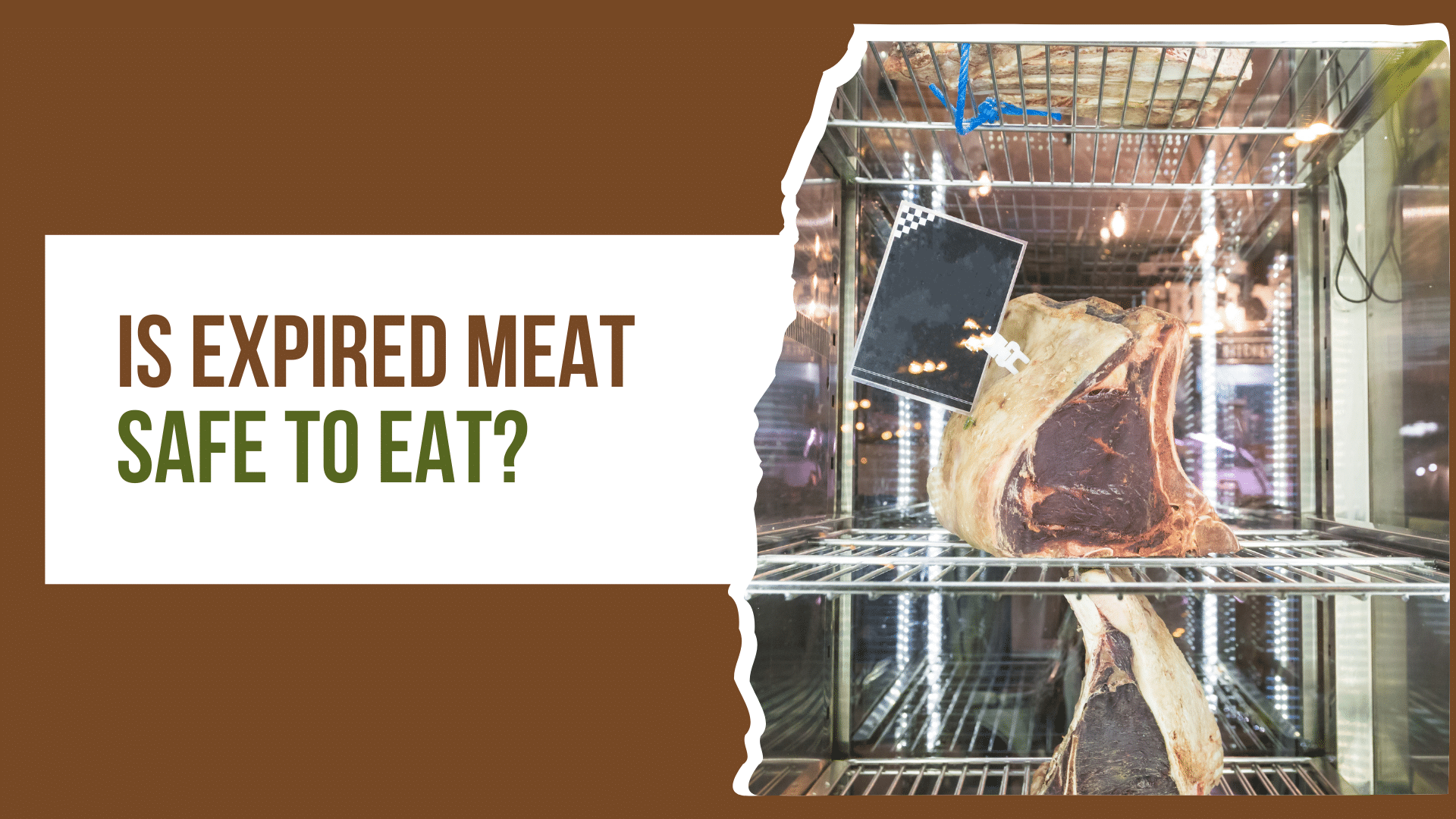Is Expired Meat Safe To Eat?
Important Note: When you buy through our links, we may earn a commission. As an Amazon Associate we earn from qualifying purchases. Content, pricing, offers and availability are subject to change at any time - more info.
Honestly, we’ve all been there. We’ve brought home a juicy steak or batter-fried fish, which then made its way into the nether recesses of our fridge. Lost to time (for a few days anyway), we stumble upon the forgotten meat and begin the debate, “should I,” “shouldn’t I,” “What’s the worst that could happen?” So, to answer the question with finality, we investigate if expired meat is safe to eat.
Advertisement
Expired meat is often still okay to eat for four or five days after it expires, depending on the type of meat and the cut. The best way to tell if the expired meat is edible is to use your senses and trust your instincts. If you’re unsure whether you should eat the meat, throw it away.
Although the expiry date on meat packaging is more of a quality than safety guideline, there is wisdom in adhering to it. Below we’ll investigate some of the hazards of eating expired meat, what you can do to preserve the meat, and the methods to ascertain whether meat is expired or not.
- What You Need To Know About Expired Meat
- Why Is Expired Meat Generally Not Safe To Eat?
- Buying Meat Past Its Expiry Date
- Are All Types Of Meat Affected By Spoiling?
- What About Buying Meat, Freezing It, Then Eating It Once Expired?
- What About Cooked Meat Kept In The Fridge For Too Long?
- So, Before Tossing That Expired Steak
What You Need To Know About Expired Meat
Although you might feel tempted to purchase that bacon on the end of the month special, please first check the expiry date. Expired meat which has spoiled poses serious health risks to those brave enough to eat it.
However, not all expired meats are bad, and only meat which has spoiled is a no-go.
Advertisement
Although meat is expired “on paper,” it may yet be okay to eat. Most shops operate within a safe margin of error, which means their sell-by date is usually several days before the meat spoils.
A shop’s expiry date and use-by date are generally orientated towards the quality of the meat and not its safety.
Before throwing the slab of tasty flesh away, you could perform several “tests” to determine whether the meat has gone on to “happy-hunting grounds” or if it’s edible.
Sight As A Guide

We, humans, are visually orientated creatures. If the meat looks like it’s going off, it’s best to throw it out. Off meat generally develops a slimy layer over it. Meat may also turn a different color (mostly gray or brown).
You may also see mold beginning to grow in extreme cases, which present as gray, green, or blue spots, and generally appear “fuzzy.” In these situations, it’s best to throw the meat away.
Trust Your Sense of Smell

Your sense of smell is usually a dead giveaway. Off meat will generally have a rancid smell to it. If the meat lacks a putrid smell, it’s probably still okay for consumption.
Advertisement
Methane, ammonia, or sulfur (rotten eggs) smelling meat is best tossed out as it has likely spoiled.
Touching & Handling The Meat Is A Giveaway
Once you’ve opened the packaging and have the meat in front of you, touching it will help you determine its off-status. If the meat feels slimy, sticky, or “squishy” in spots (if you gently press your finger into the meat and it doesn’t return to its original position), it should be discarded.
Meat is probably still okay to eat if it feels like meat should (firm to touch, not tearing/falling apart).
Tasting the Meat
Sometimes, we go a bit too far down the road of taking risks, but, once cooked, spoiled food will taste bad. At this point, it’s difficult to argue with our senses, and the food should be discarded (if you have dogs, you could probably feed it to them).
It is important not to eat more spoiled food as every bite puts you at risk.
Trust Your Gut Feeling
There is a pun in this, but when it comes to food that’s past its use-by date, we generally have that “feeling.” Listen to your gut feeling because if you ignore the whisper, you’ll have to endure the ensuing screaming!
When in doubt, rather give that piece of meat a miss.
Advertisement
Often expired meat is still salvageable for a few days after its expiry date; however, the further you pass, the more risks you take when eating it.
Why Is Expired Meat Generally Not Safe To Eat?
Although eating meat that recently expired is permissible, there is a strong consensus to discard expired meat. This consensus is well-founded in solid logic and reasoning, as eating rotting meat holds seriously adverse consequences, particularly to your health.
Eating Expired Meat Leads To Food Poisoning

Meat, and the environment, contain pathogenic microorganisms. Once the meat is exposed to room temperatures and oxygen, these bacteria multiply. These microorganisms cause food poisoning in humans when consumed.
Salmonella spp. and E. coli are two of the most significant culprits in causing food poisoning.
Symptoms of food poisoning include:
- Diarrhea (potentially bloody)
- Fever
- Muscle and stomach pain
- Nausea
- Vomiting
Other parasites may also be present in expired meat, such as liver worms (in pork), Fasciola (liver flukes), and Schistosoma (and other types of worms).
These endoparasites cause damage to human organs or live in the intestines and siphon off nutrients. In severe instances of infestation, the death of the host is inevitable.
Rather don’t consume meat that was out of a fridge overnight/through the day, particularly in warmer temperatures. Bacteria can double their numbers over 20 minutes in temperatures of between 40 and 140 °F.
If the meat stood out in these conditions, it’s best to err on the safe side and discard it. Not only are the bacteria present potentially harmful, but the toxic chemicals they produce are often heat resistant and persist after cooking.
Advertisement
Spoiled Meat’s Smell & Taste Are Off Putting
Meat is organic, which means that over time it begins to decompose. The decomposition process produces various chemical compounds released as liquids and gasses. These compounds give rotting meat an awful smell, and some may also become hazardous to consume (e.g., ammonia).
The entire decomposition process is facilitated by microorganisms found in the meat (and the environment). Bacteria, fungi, and protozoans are the major role players responsible, and while many of these are not hazardous, some may also be pathogenic. Two prime examples of decomposing or spoilage bacteria include Lactobacillus spp. and Pseudomonas spp.
The presence of decomposing microbes generally signifies the presence of pathogenic microorganisms.
Buying Meat Past Its Expiry Date
When purchasing expired meat, it is important to consider the following factors as they directly influence the safety of consuming the meat or not.
How Was The Meat Preserved?
Preservatives are unhealthy but exceptionally convenient. When we preserve things, we increase their shelf life by adding (usually) chemicals or putting the meat through a state-altering process. These chemicals and processes prevent the decomposition process from occurring.
Some preservation techniques include:
- Canning
- Curing
- Chemical treatment
- Drying
- Fermenting
- Freezing
- Salting
Most of these methods extend the meat’s shelf life for several months or even years (frozen foods can survive for a year upwards after their use-by date). Depending on how the meat is preserved, you have days, months, or years after expiration.
For example, it is usually okay to eat past its expiry date when meat is canned, provided the can remains intact and with relatively little disruption. The contents of the can may not taste the best, but it’s unlikely that they will give you food poisoning.
Preserved food lasts for longer, and even past its expiry date is safe to consume. However, it would be best always to observe and “test” preserved food before assuming it is okay to eat.
How Many Days Over The Expiry Date It Is
When purchasing meat from a store, there are usually at least two dates, a “sell-by” and a “use-by” date.
A “sell-by” date is not overly critical for us, as that is when the shop wants to get the food off of its shelves. The “use-by” date is the important one, as this is the expiry date. When purchasing meat, try and buy it a day or two before the expiry date, unless you plan on using it straight away.
It is critical to note that according to the U.S Department of Agriculture, expiry dates are not supposed to be a “you can’t use the food after this date” warning. Instead, expiry dates signify when the quality of meat begins to depreciate, and consumers should be aware of this.
Most meat should be okay to eat a day or two after it expires (up to around five days for larger cuts of beef and pork). If the meat is frozen or preserved somehow, it will be edible for longer.
If fresh, unfrozen meat was in a refrigerator and vacuum-sealed, you should be good for roughly three days.
Remember to always “test” the meat before deciding to consume it.
The Cut & Type Of Meat
How meat is cut or processed reduces its shelf life or expedites the decomposition rate.
Ground beef, for example, tends to go bad quicker than a steak or other large cut of meat. Deli meats are prone to spoiling quickly after their expiry date. Other minced/thin cut meat spoils relatively quickly as well.
You should consume ground meat (and thinly sliced meat) within one to two days of the expiry date.
A roast, steaks, and joints will last for three to five days before going bad.
Chicken, in all forms, should be consumed within one to two days of the expiry date, as spoiled chicken is one of the leading causes of food poisoning.
The shelf-life dichotomy is that thinner slices/smaller pieces of meat have a greater surface area to volume ratio. This greater surface area means that more of the meat is in contact with the surrounding air and temperature changes, providing the ideal habitat for bacteria to invade and spoil the food.
These guidelines are aimed specifically at the quality of the meat, but as the quality depreciates, food poisoning increases.
Are All Types Of Meat Affected By Spoiling?
Using your senses to test whether meat has spoiled is not limited to beef. Chicken, pork, fish, and other types of meat will give you similar telltale signs that they are past their safe to eat date. However, there might be some variation in the signs and symptoms.
It is not advisable to eat any spoiled meat, no matter the species, as risks are involved.
The Risks of Eating Expired Beef
Expired beef risks food poisoning, as some bacteria invade the meat after processing. Bacteria present in expired meat include:
- Salmonella spp.
- E. coli
- Yersinia spp.
The Risks of Eating Expired Chicken
Chicken, like beef, harbors and facilitates bacterial growth once exposed to air and warm temperatures. When eating uncooked chicken, food poisoning is one of the biggest risks.
Some food poisoning causing bacteria found in chicken include:
- Campylobacter spp.
- Salmonella spp.
- Clostridium perfringens
You should throw out any spoiled chicken. Although cooking kills many surface-dwelling bacteria, those deeper in the meat, and the toxic chemicals they leave in their wake, may not be destroyed during cooking.
The Risks of Eating Expired Pork
Eating expired and spoiled pork risks developing trichinosis (food poisoning), generally caused by trichinella spiralis, a microscopic worm.
When you eat contaminated pork, you ingest the larvae inside cocoon-like structures. After digestion, the mature worms are free to lay eggs in your muscle tissue.
Symptoms of trichinosis include:
- Constipation or diarrhea
- Stomach pain
- Fatigue
- Fever
- Headaches
- Muscle pain
- Swelling
Individuals may experience difficulty breathing, coordination, and inflammation around the heart in severe cases.
The Risks of Eating Expired Fish
Fish which has passed its expiration date is also not recommended, as eating it could lead to ciguatera and scombroid poisoning.
The symptoms of ciguatera poisoning include:
- Diarrhea
- Difficulty distinguishing hot from cold
- Headaches
- Itchy or numb skin, lips, or tongue
- A metallic taste in your mouth
- Muscle aches
- Nausea
- Stomach cramps
- vomiting
Scombroid poisoning resembles an allergic reaction with:
- A red flushed face
- Abdominal pains
- Hives
- Nausea
- Vomiting
Another bacteria often found in shellfish is Vibrio vulnificus. Infection by this bacteria causes the usual food poisoning symptoms.
What About Buying Meat, Freezing It, Then Eating It Once Expired?
Meat bought before the expiry date and frozen immediately upon arriving at home is safe to eat past the expiry date.
This safe consumption is not influenced by the type of cut either.
The most significant downside of keeping meat frozen past its expiry date and then consuming it is that it loses its quality, flavor, and nutritional value.
For example, frozen ground beef lasts up to four months, provided it stays frozen and doesn’t defrost during this time. If kept for longer than four months, the meat will still be okay to eat, but it won’t taste as good when cooked.
What About Cooked Meat Kept In The Fridge For Too Long?

Many of us like to cook bigger portions and then freeze them or consume them over the next few days while staying in the fridge. While doing this is okay, it’s important to remember that bacteria still breeds and spreads through food in the refrigerator.
The cooking process adds a few extra days of “freshness” to your food, but anything longer than four or five days is a risk for most meats. Larger roasts and dried goods are okay for up to two weeks.
For example, uncooked chicken lasts for a day or two, while cooked chicken lasts for three to four days.
Food that was cooked and frozen almost immediately should, in theory, keep its quality and safe to eat status for months. The most critical factor is the ambient temperature the food was exposed to. If it was left out in the day’s heat, even a couple of hours might cause the food to pass.
So, Before Tossing That Expired Steak
Remember to inspect all meat (and food in general) for signs of spoiling. Sell-by and use-by dates are more of a quality guideline, so trusting your senses is the primary way of determining whether meat has spoiled or not. The most critical thing is not to take chances. You risk food poisoning and other unsavory consequences if the meat has turned (spoiled). No rib-eye steak is worth the risk. If you’re unsure, rather discard the meat.


 Please Support Me on Ko-fi
Please Support Me on Ko-fi